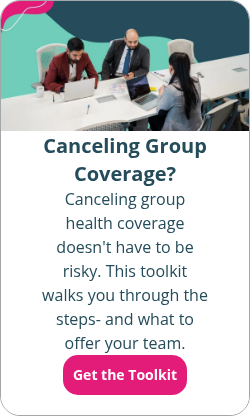What is a group in group health insurance?
By Elizabeth Walker on July 12, 2024 at 9:30 AM
The Affordable Care Act (ACA) mandates that applicable large employers (ALEs) provide health insurance coverage to at least 95% of their full-time employees or face steep IRS penalties. However, the law excludes small employers with fewer than 50 full-time equivalent employees (FTEs) from the mandate.
Even though there’s no legal requirement, small employers should still provide essential health benefits to recruit and retain talented workers. Many small organizations try to make their compensation packages more attractive by adding a group health plan.
As the name employees, group health plans require a certain number of employees to participate. However, these group health insurance requirements are often challenging for small employers. In this blog, we’ll discuss the nuances of group health insurance, how many employees you need to qualify for group health insurance, and the alternatives available to you.
Takeaways from this blog post:
- Insurance companies and individual states typically require employers to enroll 70% of their full-time employees in a group health insurance plan to prevent adverse selection.
- Small organizations with between two and 50 FTEs can still be eligible for group health coverage, called small group health insurance.
- Employers with group health insurance can supplement their policy with an integrated health reimbursement arrangement (HRA) to provide greater coverage. Business owners can also choose an alternative health benefit to group plans by offering a qualified small employer HRA (QSEHRA) or an individual coverage HRA (ICHRA).
How many employees do you need to qualify for group health insurance?
Unlike individual policies, traditional group health insurance is a single policy issued to a group of people and their dependents. Because group health coverage is typically associated with large employers, many small organizations wonder whether they’re eligible for group coverage.
Luckily, there’s group coverage specifically designed for small employers, known as small group health insurance. To be eligible for a small group health plan in most states, a company must have between two and 50 FTEs. Organizations in California, Colorado, New York, and Vermont can offer small group coverage if they have fewer than 100 employees.
You can enroll in the group plan if you're the sole proprietor. However, at least one other FTE who isn’t an owner must enroll in the employer-sponsored health plan to qualify.
The other employee must be someone who is:
- Not an owner or employer
- Not the spouse of an owner or employer
- Not a family member of the owner or employer
- Not a partner of the owner or employer
- Not a seasonal worker, even if the person works full-time during that period of time
- Usually not an independent contractor of the owner or employer
If you’re an employer with 50 or more FTEs, the federal government considers you an ALE. In most states, you won’t qualify for small group health insurance. Instead, you can apply for large group coverage. You’ll need to meet group health coverage reporting requirements and meet group plan standards, like offering insurance that meets minimum essential coverage (MEC).
Do small businesses have to provide health insurance to employees?
While employers with fewer than 50 full-time employees aren’t legally required to offer health insurance, many still choose to do so. Offering health benefits is a great way to improve recruitment and retention, which is vital for an employer of any size.
According to our 2024 Employee Benefits Survey, 81% of employees say that an employer’s benefits package is an essential factor in whether they accept a job. Additionally, 92% of employees believe health benefits are one of the most important perks to have at a company.
Offering comprehensive health benefits contributes positively to talent acquisition and retention. Happy and healthy employees tend to be more loyal, productive, and satisfied with your business. While health insurance plans can be costly, it’s in your best interest as a small business to offer a health benefit to stay competitive.
What are the participation requirements for a group health insurance plan?
Insurance carriers typically require organizations to meet minimum participation rules to purchase a group health insurance policy1. For health insurers, participation is the percentage of full-time employees who enroll in the group plan. States and insurance companies set their own rates, but the minimum percentage is generally around 70%.
This requirement aims to prevent “adverse selection,” meaning only frequently ill individuals sign up for medical coverage, creating a high-risk group. By requiring a specific percentage of eligible employees to enroll, the insurance company broadens the pool of people and avoids groups comprised mainly of individuals in poor health.
Most insurers typically require you to enroll at least 70% of your uninsured, full-time employees. If some of your employees have self-only coverage, they won’t count toward the participation requirement. The same is true if you have employees covered by their spouse’s insurance plan.
If you’re looking for a way around the 70% rule, there’s an exception. The participation rule isn’t applicable if you enroll in a group plan through the Small Business Health Options Program (SHOP) during the annual open enrollment period2.
This makes the open enrollment period the best time to enroll if you know you’ll have employees who won’t participate in your group health plan to ensure your company can get coverage. However, only some states still have SHOP exchanges.
How can employers supplement their group health insurance plan?
Rising healthcare costs can leave small employers feeling like they must settle for a reasonably priced but less comprehensive policy. However, the good news is that employers can supplement that coverage with an integrated health reimbursement arrangement or a health stipend.
Integrated HRA
An integrated HRA, or a group coverage HRA (GCHRA), is an arrangement between an employer and employee designed to reimburse employees for medical costs their group health insurance policy doesn’t fully cover.
An integrated HRA supplements the group health plan by helping to pay for out-of-pocket medical expenses only. Employees can’t request reimbursement for group insurance premium payments. Instead, employees can use the HRA’s allowance on coinsurance, copayments, and other qualified out-of-pocket costs.
Employers can set unique cost-saving rules regarding minimum deductibles, cost-sharing, explanation of benefits, and allowable expenses the GCHRA can reimburse to make the health benefit even more budget-friendly. And like with the excepted benefit HRA (EBHRA), employers can set different eligible employee classes.
Employee classes separate employees into groups by job-based criteria, such as full-time and part-time employee status. To save you even more money, you can offer employees in different classes different allowance amounts.
Health stipend
With a health stipend, a small business can offer its employees a fixed amount of money to help them pay for out-of-pocket costs outside their traditional group health plan, like dental coverage, entire premiums, and more. Employers can administer the stipend weekly, monthly, or annually. Business owners typically include the amount in their employees’ paychecks as extra income.
It’s up to your employees how they want to spend the money. You can't dictate its use even if this additional employee benefit plan is for out-of-pocket medical costs.
It’s also important to note that stipend money is taxable income for the employee, and employers must pay payroll taxes on the amount. However, because the IRS considers stipends taxable non-wage income, you can offer them to employees who qualify for a premium tax credit and contract workers, like 1099 employees.
What are small business alternatives to group health insurance?
We know employer-sponsored health insurance plans play a significant role in recruiting and reducing employee turnover. Still, only some small businesses can offer group health insurance due to the high cost and participation requirements. Thankfully, there are additional coverage options. Instead of offering traditional group benefits, more employers are choosing a stand-alone HRA to cover their employees’ medical services.
An HRA is a flexible alternative to traditional group medical plans that can help businesses of all sizes control healthcare costs. With an HRA, you set a monthly allowance for your employees to buy medical services and items. Then, you reimburse employees tax-free for out-of-pocket costs, including individual plan premiums, after they incur an eligible expense.
Two common types of HRAs are the qualified small employer HRA (QSEHRA) and individual coverage HRA (ICHRA). Both are exempt from minimum participation rules and offer tax benefits.
Qualified small employer HRA (QSEHRA)
A QSEHRA allows small business owners to reimburse their employees for qualified medical expenses, such as monthly premium costs, over-the-counter medicine, preventive services, and more.
While QSEHRAs have an annual maximum contribution limit, there’s no minimum limit to what you can offer. Additionally, employees must have a qualified health plan with MEC to participate in the benefit.
To offer a QSEHRA, you must:
- Have fewer than 50 full-time employees
- Not offer a group plan, including health insurance coverage through SHOP or a flexible spending account (FSA). If you currently offer a group plan, you can cancel it and offer a QSEHRA instead
- Provide the HRA on the same terms to all full-time employees. You can also offer the benefit to part-time employees as long as they receive the same allowance as full-time workers. However, you can differ allowances by family status
If your employees are paying for their health insurance policy with premium tax credits, they may still be able to benefit from the QSEHRA. If your QSEHRA allowance is affordable, they must waive their tax credits. However, they can keep the QSEHRA and their tax credits if it's unaffordable. But they’ll need to reduce their tax credits by the amount of your QSEHRA allowance.
Individual coverage HRA (ICHRA)
If a QSEHRA isn’t suitable for your small business, you can offer an ICHRA. Employers of any group size can offer an ICHRA and make contributions of any size, too—no minimum or maximum allowance amount applies.
Employees must have a qualifying form of individual insurance coverage or Medicare to participate. Like the QSEHRA, reimbursements are tax-free.
Employers can design their ICHRA benefits based on 11 employee classes, making it more flexible and customizable than the QSEHRA. You can vary the allowance for each class you set. However, you must provide the same terms to all employees within the same class.
Employees can opt in or out of the ICHRA, depending on affordability. If your employees are eligible for premium tax credits, they must waive their credits if their ICHRA benefit is affordable. They can opt out of the ICHRA benefit and collect their subsidy if it's not affordable.
Regardless of your choice, QSEHRAs and ICHRAs allow employers to set their own budget for a health benefit that provides value to all employees with no minimum contributions or participation rate requirements attached.
Conclusion
Many employers want group health insurance coverage for their organization. However, only some qualify for group coverage plans. Small employers may be unable to afford it or have too small of a group interested in enrolling in the benefit. If you have a small business, determining eligibility and additional requirements is crucial before applying for health insurance.
Luckily, you still have other solutions if you’re ineligible for a group plan. If you’re looking to supplement your existing group health plan with a GCHRA or want a group health alternative like a QSEHRA or ICHRA, PeopleKeep can help. Contact us, and we’ll set you up with the right HRA for your company.
This post was originally published on November 12, 2020. It was last updated on July 12, 2024.
Check out more resources
See these related articles

What is healthcare reimbursement?
Looking to reimburse your employees for their healthcare expenses? Learn everything you need to know about healthcare reimbursement.

What is group health insurance?
Curious about group health insurance? This comprehensive guide explains the ins and outs of group coverage and how it works for your organization.

Offering a QSEHRA vs. group health insurance
Compare QSEHRA with group health insurance. Learn the differences in cost, flexibility, and benefits to help you choose the best option for your business.



